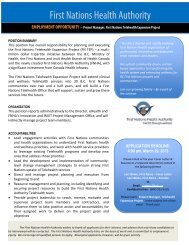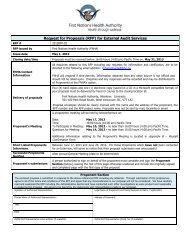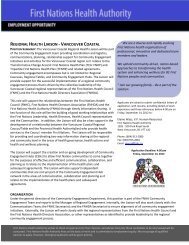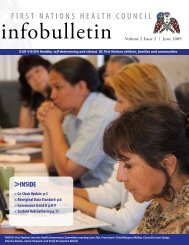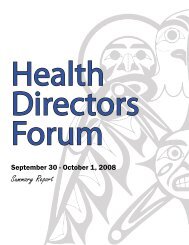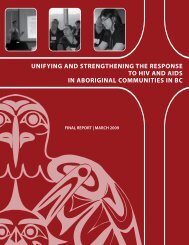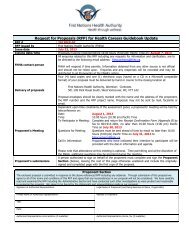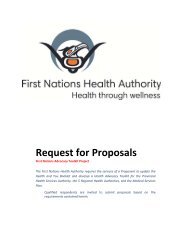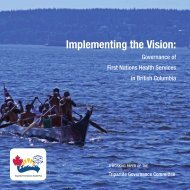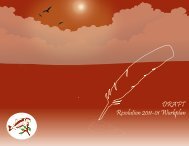FNHC Infobulletin Volume 1 Issue 3 | October 2008 - First Nations ...
FNHC Infobulletin Volume 1 Issue 3 | October 2008 - First Nations ...
FNHC Infobulletin Volume 1 Issue 3 | October 2008 - First Nations ...
Create successful ePaper yourself
Turn your PDF publications into a flip-book with our unique Google optimized e-Paper software.
<strong>First</strong> <strong>Nations</strong> Health Council | <strong>October</strong> <strong>2008</strong> <strong>Infobulletin</strong> | page 4Community Spotlight: Ktunaxa <strong>First</strong> NationAbout the Ktunaxa NationKtunaxa citizenship is comprised of Nationmembers from seven Bands located throughouthistoric traditional Ktunaxa territory. FiveBands are located in British Columbia, Canadaand two are in the United States. ManyKtunaxa citizens also live in urban and ruralareas “off reserve”. Ktunaxa (pronounced‘k-too-nah-ha’) people have occupied the landsadjacent to the Kootenay and Columbia Riversand the Arrow Lakes of British Columbia,Canada for more than 10,000 years. In totalthe Ktunaxa Nation is comprised of approximately5,000 individuals, though a census tobe carried out next year will clarify this numberfurther.Creating a Governance ModelThe Ktunaxa Nation is putting governancefirst. Over the past 9 years the Ktunaxa havedeveloped a governance model that combinestraditional governing structures, indigenouspedagogy, and fiscally accountable checksand balances. The model was developed overa decade through a grassroots process ofcommunity meetings, focus groups and sectorspecific workshops.“At the time that we entered the treatyprocess we did two things,” comments GwenPhillips, Governance Transition Coordinator,“we committed to exercising personal andgeographic jurisdiction over our land and ourpeople, and at the same time committed to acommunity development agenda.” A communitydevelopment agenda commits us toconsulting with our citizens and acting upontheir recommendations on a consistent andfrequent basis. We havewhat we refer to as acitizen-driven processthat guides our treaty negotiations.The existingCouncils direct governancetransition, basedon the people’s agenda.The cornerstone of thisagenda is the notion that“you can only move as fast as the people.”The Ktunaxa have organized their nation into 5sectors including: Social Investment, TraditionalKnowledge, Corporate Services, Land &Resource Stewardship, and Economic Development& Investment Planning. Each sector isgoverned by a sector specific council composedof individuals with expertise that sectorarea. The role of the sector council is to “Providestrategic direction for government.” Inthe future, each sector councilwill be governed by a Chief whohas experience and expertise intheir given area. This model, 9years in the making is currentlybeing adopted by the Ktunaxa.A Ktunaxa constitution is alsoin the works and is expected tobe completed next year. Whenasked why the Ktunaxa have focusedso strongly on governanceGwen comments: “I think for usthe important thing is to knowyour limits. You set the outmostboundaries for what you can doas a nation and to know wherethose boundaries are. You don’thave to exercise jurisdictionin all of those areas, but it is ahuge learning opportunity tofind out where those limits lay.Then you have choice.”“We have what we refer to as a citizen-driven process thatguides our treaty negotiations. The existing Councils directgovernance transition, based on the people’s agenda. Thecornerstone of this agenda is the notion that “you can onlymove as fast as the people.”The Ktunaxa NationSocial SectorAn important step in building agovernance model is establishingthe core ideas/principlesthat your government willadhere to and promote. Theseideas, also serve to define the populations thatyou intend to serve. Early on in the process theKtunaxa developed the following guiding principlesfor the delivery of Aboriginal health andwellness services by the Ktunaxa government:• Authority for health planning in the KtunaxaTraditional Territory and the associated administrationof resources will rest with the KtunaxaNation.• The interests of all Aboriginal people wholive in Ktunaxa Territory will be represented inall (regional) Health Planning sessions.• All Aboriginal people will be eligible to accessthe same level of services regardless of statusor residency.• Common Aboriginal values will be integratedinto planning and service delivery.• All Aboriginal people of this area will worktogether, nurturing and celebrating our commonidentity.Through the development of these principles,the Ktunaxa define their role as being responsiblefor health planning for all Aboriginalpeople within their traditional territory. Asthere are no friendship centres and very fewAboriginal organizationswithin the Ktunaxaterritory, the Nation hasmade a commitmentto ensuring that theinterests of all Aboriginalpeople are includedin their processes.Seats have been madeavailable on KtunaxaBoards and committees for Métis and Urbanrepresentatives, as required. When planning,special sessions have been held in keylocations throughout their territory, to permitoff-reserve Aboriginal people to participate.PartnershipsCollaboration and Partnerships are necessaryingredients in the delivery of quality healthcare, especially for many small <strong>First</strong> <strong>Nations</strong>.The Ktunaxa are currently concluding a Letter



